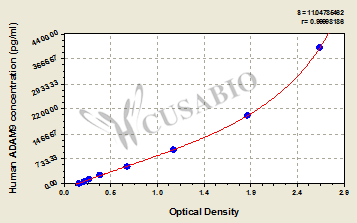The ELISA Kit is designed for quantitatively measuring human ADAM9 levels in samples, including serum, plasma, tissue homogenates, cell culture supernates, or ascitic fluid. It uses the sandwich enzyme immunoassay technique in combination with the enzyme-substrate chromogenic reaction to quantify the analyte in the sample. The color develops positively to the amount of ADAM9 in samples. The color intensity is measured at 450 nm via a microplate reader.
ADAM9 is a metzincin cell-surface protease involved in several biological processes such as myogenesis, fertilization, cell migration, inflammatory response, proliferation, and cell-cell interactions. It is involved in inflammation, degenerative diseases, and cancer. In inflammation, ADAM9 contributes to monocyte fusion, mediating the conversion of monocytes-macrophages to multinucleated giant cells (MGCs) in response to foreign bodies or bacteria. The generated granulomatous lesions help to isolate the pathogens and also enhance phagocytotic activity. ADAM9 has been found over-expressed in several solid tumors such as glioma, melanoma, prostate cancer, pancreatic ductal adenocarcinoma, as well as gastric, breast, lung, and liver cancers. Upregulation of ADAM9 is associated with tumor aggressiveness and poor prognosis.





